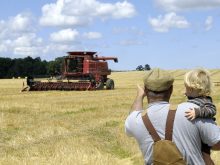A Feb. 23 Associated Press story about BSE testing in the United States raised eyebrows on this side of the border last week.
AP reported that the only BSE testing lab in the Pacific Northwest will close today, March 1, as will several other locations across the country.
The reason? The U.S. Department of Agriculture has determined the prevalence of the disease is “extraordinarily low.” That’s why it is reducing its BSE testing by more than 90 percent, said the AP story.
The U.S. has found three cases of BSE among the 759,000 samples it has tested from its national herd of about 97 million animals. That’s a testing rate of 0.78 percent.
Read Also

Crop profitability looks grim in new outlook
With grain prices depressed, returns per acre are looking dismal on all the major crops with some significantly worse than others.
Canada has found nine cases in the approximately 146,200 samples it has tested. Its national herd is about 14 million animals, for a testing rate of 1.05 percent.
No one with even the faintest interest in the health of the cattle industry would want the U.S. to discover more cases.
But ever since the post-2003 testing program began discovering cases here, Canadians have wondered about the lack of a similar pattern across the line. Given the level of pre-BSE cattle trade, it seemed logical to expect more cases on both sides of the border.
Procedure is a big part of the answer.
Canada tests samples primarily from the four Ds: animals that are distressed, diseased, down or dead. It tests animals that science indicates are the most likely to have BSE, if it exists at all in a herd. And Canada actually tests more animals, on a percentage basis, than the U.S. does.
The American system is based on surveillance, which is a way to test incidence rather than a method of isolating all cases. They aren’t looking for it in the same way that Canada is, and as the record shows, they aren’t finding it in the numbers that Canada has.
The U.S. randomly tests animals of various ages at the plant level. Those are augmented by samples from rendering plants, where 4D animals would appear.
We could criticize the U.S. for reducing its level of BSE testing, just as Washington state ranchers criticized Canada last week for alleged import infractions that it said exposed the U.S. to increased risk of BSE.
Pointing fingers is easy, especially before all the facts are known. And yes, it rankles.
But let’s not forget a fact often lost amid the battles surrounding BSE: the equivalent human affliction, variant Creutzfeldt-Jakob Disease, remains extremely rare. There has been no increase in North American cases and no one in North America has ever contracted vCJD or died as a result of eating BSE-contaminated North American beef. Safe food is what it’s all about.














